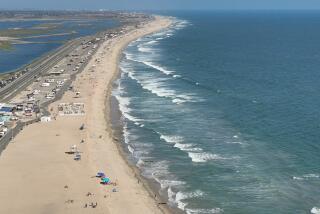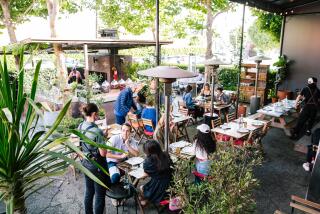Humans’ nature in Newport’s Back Bay
Newport Beach — At 7:45 on a Saturday morning, the pelicans of Upper Newport Bay Ecological Reserve were still sleeping. I suspect my husband wondered why we weren’t too. But my goal for the weekend was to be out in nature, and nature begins early.
Back Bay, as it’s known, is not the largest or most beautiful wetland in the state. It’s certainly not the most pristine. But what makes the bay worth visiting, what can make me go almost sappy describing it, is that it stands as proof that nature can exist cheek by jowl with humans.
Tall cliffs that run along the bay have created a long, narrow estuary in which salt water coming in from the ocean mixes with fresh water flowing from streams and storm drains. Up on the hills, houses and condominiums have been built to the edges of the cliffs. But at bay level, if you focus on the middle distance, all you see are the shallow channels, islands and grasslands that have created an ideal environment for spawning fish, for migrating shorebirds and ducks, for raccoons and foxes. Carl and I wanted to take it all in.
The drive to Newport from our house in Echo Park earlier this month took only 45 minutes, so we had time to orient ourselves before a 9 o’clock nature walk sponsored by the Newport Bay Naturalists and Friends. The quickest way to get a sense of the area is to drive along Backbay Drive, a one-way street that hugs the bay’s south edge, so that’s what we did, pulling over several times to take in the sweep of blue and green and brown, the herons and egrets poking in pools for fish, the thousands of migratory shorebirds.
Soon it was time to be back at the south end of the bay, where hikers were gathering. Guided by volunteer naturalists, we learned about the rail, a shy, thin shorebird that anchors its nest to grasses so that when the tide is high, the nest doesn’t float away. But a group of middle school kids slowed us to a glacial pace, and one of the docents suggested that if we really wanted a hike, we could drive half a mile up the road and park at Big Canyon (actually a small canyon).
There our luck picked up. Two men noticed our binoculars.
“You birders?” they asked.
“We like birds,” I said.
“We just saw a black rail,” they said excitedly, explaining that they were among the rarest of the area’s birds. “We’re going up the road to see if we can find clapper rails.”
The endangered clapper rail is one of the great success stories of the nature reserve. More than 70% of all remaining rails make their home here, though seeing one is difficult.
“They tend to live and nest on the islands out in the middle of the bay,” said one of the men, Martin Byhower, a science teacher at Chadwick School in Palos Verdes and a professional bird guide. “But today the tide is so high that those islands are all flooded. They’ve probably flown over to the shore that runs along the road.”
After about half an hour, Byhower announced he had sighted a species of rail known as a sora, distinguishable by its bright yellow beak. Seeing the bird was thrilling, but we still wanted a hike and so decided to head on over to the interpretive center on the northeast shore.
A wall display there concisely laid out the area’s history, from the time when Native Americans used it as a hunting and fishing site through the encroaching development of the 1950s and ‘60s and finally to its salvation, when Newport Beach citizens formed a conservation group and purchased the land from a developer, the Irvine Co.
Along hiking trails we had close encounters with two dozen species of birds and small mammals and had sweeping views of the 752-acre reserve. But after a couple of hours, we were tired, hungry and ready to trade nature for luxury -- for a while.
It wasn’t quite check-in time at the Hyatt Newporter, a sprawling 403-room resort on a hill above the bay, but that was no problem, the clerk told us, with the graciousness we would experience from all the hotel staff during our stay. Of course our room was ready.
Our auto club rate was $108 a night, or about a third off standard prices. The room was generic but nice. Big. Comfortable. Lots of towels. A small balcony overlooked a golf course. In a courtyard outside lay one of the hotel’s three pools and a whirlpool.
A late lunch on the patio of the hotel’s Jamboree Grill also proved better than expected. Salmon club and Southwest chicken salads were fresh and the salmon was cooked rare, just as we had ordered.
After a soak in the whirlpool, another walk along the bay and some relaxing, it was time to think about dinner. When I was in college, for reasons I can’t recall, friends and I decided to fast for 48 hours. During that time we mostly thought about how we would break our fast. One of the group had the idea to get Alaskan king crab at the Crab Cooker in Newport. What we ate that night has lived in my memory as the best crab I’ve ever had.
Revisiting a perfect memory is risky but, in this case, not devastating. The Crab Cooker is as kitschy as ever. (A great white shark hangs from the ceiling.) Dinners are served on disposable plates with plastic utensils. No reservations are taken. After a 40-minute wait, we had a table.
We both got crab, one order with potatoes, the other with rice pilaf. When the plates came, side dishes were irrelevant. This was about digging huge hunks of sweet crab out of absurdly long, pointed shells. Was it as good as I remembered? Of course not. Was it delicious? Absolutely.
Sunday I arose early and left my sleeping husband. Passing the hotel gym on a lovely, sunny morning, I couldn’t believe that half a dozen hotel guests were jogging on treadmills rather than outside. Feeling self-righteous, I ran along the bay for a short while and then up into Big Canyon, past a pond, across a stream and up a wide dirt road. It was beautiful.
After a good breakfast of an omelet (mine) and huevos rancheros (Carl’s), we checked out and headed to the Newport Dunes trailer park across the street for the nature center’s weekly guided kayak trip. We were the only people who showed up, so we had guide Bob Smith to ourselves. We’ve done a fair amount of kayaking and know how to wield a paddle, so we set right off past a small marina and into the nature reserve.
On a fast-moving tide, we quickly got out into the main part of the estuary. Within minutes we had seen an osprey high up on a pole, a noisy kingfisher skimming the water, two kinds of hawks and hundreds of mullets leaping out of the water.
We settled into the rhythm of stroke, glide, stroke, glide, and we felt for the first time on our quick trip that we were part of the bay. The houses on the hillsides retreated into the distance, and we began to notice that the farther we paddled toward the freshwater inlets, the less salty the air smelled. Our guide was informative but not intrusive, content to just experience nature. And then the tide turned, and it was time to turn back.
Sue Horton is editor of the Sunday Opinion section.
More to Read
Sign up for The Wild
We’ll help you find the best places to hike, bike and run, as well as the perfect silent spots for meditation and yoga.
You may occasionally receive promotional content from the Los Angeles Times.







